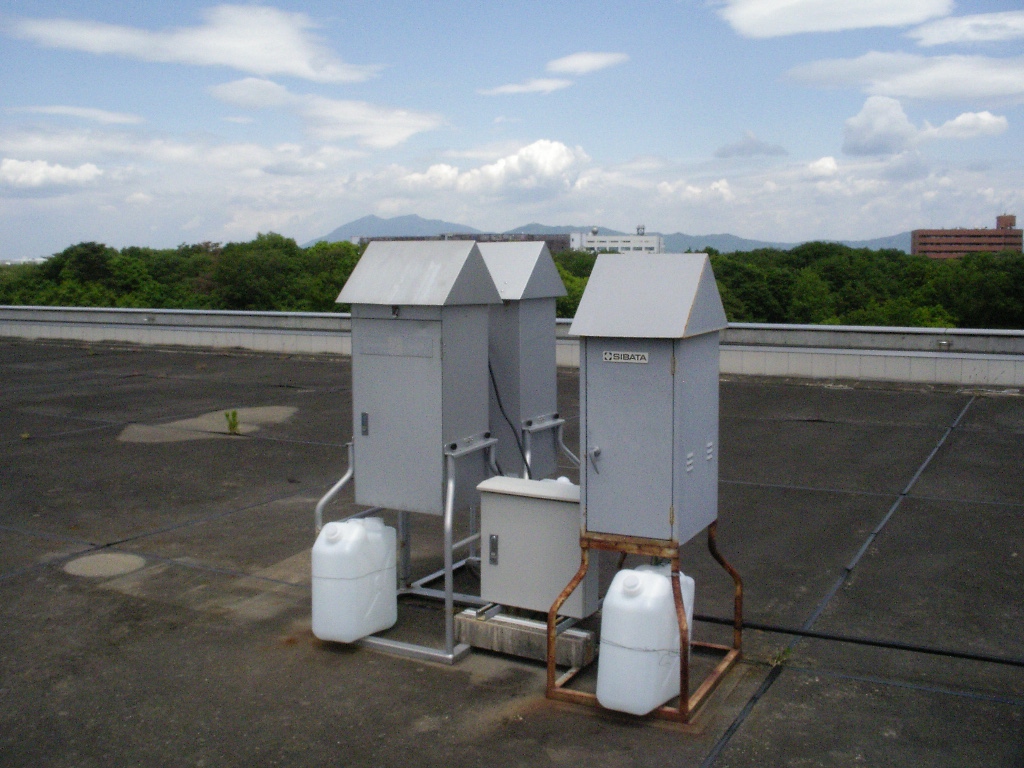Bulletin of the Geological Survey of Japan Top Page
Bulletin of the Geological Survey of Japan Vol.65 No.11/12 (2014)
Cover photograph | Table of Contents | Abstract
Cover photograph
Samplers used for aerosol samples
These equipment are the aerosol samplers settled on the rooftop of the 7-8 building of the Geological Survey of Japan. They were installed to observe the dust events such as Asian Dust during the Japan-China joint research project conducted from 2000 to 2004. Details of the project are reported in this Bulletin (vol. 54, p.251-267, p.303-322; vol.56, p.259-272, p.273-301). The machine on the left side is a high volume air sampler and the one on the right side is an Andersen-type low volume air sampler. Although they were exposed to the weather and became old and decrepit, they are used again for the observation of aerosol after the Fukushima Dai-ichi Nuclear Power Plant accident in 2011.The mountain behind them is Mt.Tsukuba.
(Photograph and Caption by Yutaka Kanai)
Table of Contents
All the pages PDF : 65_11_full.pdf [3.1MB]
| Title | Author | |
|---|---|---|
| Article | ||
| On well water and sea level changes witnessed before the 1946 Nankai earthquake on the Pacific coast of Shikoku, Japan |
Yasuhiro Umeda and Satoshi Itaba
(p.129-144) |
65_11_01.pdf [2.1MB] |
| Observation of radionuclides transported with aerosols at the GSJ in 2013 and investigation of their re-suspension |
Yutaka Kanai
(p.145-155) |
65_11_02.pdf [962KB] |
Abstract
On well water and sea level changes witnessed before the 1946 Nankai earthquake on the Pacific coast of Shikoku, Japan
Yasuhiro Umeda and Satoshi Itaba
This study investigates the vertical crustal movement in the period approaching the 1946 Nankai earthquake. To obtain data for just before the main shock, we examined witness testimonies on well water and sea level change that might relate to vertical crustal changes. The testimonies were taken into consideration along with existing documents and local knowledge of the inhabitants of the Pacific coast of Shikoku. The water in a few wells decreased or dried up about 1 week before the main shock. Abnormal changes in sea level were witnessed several days before the main shock. From several hours before the main shock, fishing boats returning to port could not dock at the port because the sea level was too low. On the contrary, there were also testimonies of those who noticed no lowering of sea level. The generation of a tsunami is proposed as the explanation of the abnormal changes of sea level and conflicting testimonies.
Observation of radionuclides transported with aerosols at the GSJ in 2013 and investigation of their re-suspension
Yutaka Kanai
In order to obtain the geochemical knowledge of material cycle as a tracer and to contribute the concern of inhabitant about safety after the accident of the Fukushima Dai-ichi Nuclear Power Plant (FDNPP), the aerosol observation at the Geological Survey of Japan, AIST (GSJ) was continued and the new data in 2013 are reported in this paper. The Cs radioisotopes in aerosols increased a little in March 2013, then decreased from April. Those in 2012 also decreased in April, when the southerly wind often blew instead of northerly wind and rainy day increased. These facts suggest the change of weather conditions is one of controlling factors. The re-suspension of deposited particles by strong wind was thought to be more important mechanism after 2012 than the transport from the FDNPP. The Cs-137 concentration and Cs-137/Pb-210 ratio were thought to be useful parameters suggesting the re-suspension.
Geological Survey of Japan, AIST
- About GSJ
- Our Activities
- Purchase guide
-
Publications and Database
- information
- Bulletin of the Geological Survey of Japan
- bull2025(Vol.76)
- bull2024(Vol.75)
- bull2023(Vol.74)
- bull2022(Vol.73)
- bull2021(Vol.72)
- bull2020(Vol.71)
- bull2019(Vol.70)
- bull2018(Vol.69)
- bull2017(Vol.68)
- bull2016(Vol.67)
- bull2015(Vol.66)
- bull2014(Vol.65)
- bull2013(Vol.64)
- bull2012(Vol.63)
- bull2011(Vol.62)
- bull2010(Vol.61)
- bull2009(Vol.60)
- bull2008(Vol.59)
- bull2007(Vol.58)
- bull2006(Vol.57)
- bull2005(Vol.56)
- bull2004(Vol.55)
- bull2003(Vol.54)
- bull2002(Vol.53)
- bull2001(Vol.52)
- Bulletin of the Geological Survey of Japan(old)
- Annual Report on Active Fault and Paleoearthquake Researches
- Reports, Geological Survey of Japan
- CCOP-GSJ Groundwater Project Report
- CCOP Technical Bulletin
- Cruise Report
- Geological Hazards
- Learning and Education
- GSJ Database Collection
- Collection of links


